Pneumonia is the single greatest cause of death in young calves. Prevention is always better than a cure. This is where knowing the source of calves can be worth a lot to the beef farmer. Calves need to have received adequate colostrum in the first 24 hours after birth.
While in the ideal world, calves would be vaccinated against pneumonia prior to moving farm, in reality this is not going to happen. Consult your vet about the best approach for your farm with regard to pneumonia vaccination.
Vaccination is a tool in the toolkit to help in pneumonia prevention
Know that a vaccine will not work on a stressed calf and therefore calves should be allowed to settle into the farm for 48 hours prior to vaccination.
Vaccination is a tool in the toolkit to help in pneumonia prevention. A good environment in terms of deep dry-bedding, adequate ventilation and draft management are also essential.
Calf bloat can be an issue in the calf shed any given year. However, speaking to farmers around the country, there seems to be more instances of the problem this year.
Bloat in calves is different to larger animals in that it is the milk stomach or abomasum that rapidly fills with gas, while for older cattle it is the first stomach, or rumen that swells.
Minor cases of bloat occur when the left-hand side of a calf seems swollen
This means that stomach-tubing a calf with bloat is less effective as the tube typically stops in the rumen of a calf that is a few weeks old.
Minor cases of bloat occur when the left-hand side of a calf seems swollen. In bad cases, where both sides of the animal are inflated and extremely hard to the touch, it is recommended that you call your vet who can put a needle directly into the abomasum to relieve the pressure.
Cause
Bloat can occur a few days after arriving on farm, especially for calves transitioning from fresh milk to milk replacer.
Other areas to consider, which can be a source of the problem, revolve around feeding – both hygiene and feed consistency.
Treatment
Treatment for minor instances can be successfully done using baking soda or liquid paraffin.
Isolated instances are not too much of a worry. Where is it a common issue, the first thing you should do is go back to basics. How clean is your feed preparation equipment and feeder (see below). Are you mixing milk replacer exactly to the manufacturer’s recommended rate? Are you weighing out milk replacer accurately? Is your water measurement accurate?
Pulling back the proportion of milk powder for a few days while keeping the water level the same can be a good way to get the problem to settle. Once the issue disappears, you can start to increase the milk powder slowly back to the recommended feed rate.
Having access to clean water at all times is also very important for calves. Milk to calves is a feed and not a drink. Calves have a requirement for water as well. Where water intake is reduced, it can lead to bloat issues or stomach upsets.
Water feeders need to be at the correct height for calves to drink from and should be checked twice daily to ensure water is fresh.
Having feeding equipment perfectly clean for calf-rearing is of utmost importance for calf health.
While visiting a farm that was preparing for calf arrival recently, the topic of teats on the calf feeder came up.
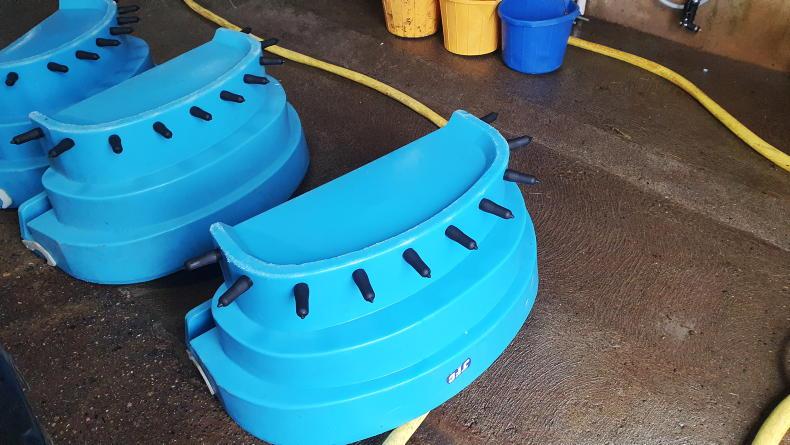
Hygiene around calf feeding equipment is really important in preventing disease outbreaks.
The farmer planned to change any teat that was cracked or leaking but was planning on just changing those that looked like they had seen better days.
The feeders had been thoroughly washed and cleaned with hot water at the end of the rearing phase last year and were stored dry in a shed loft.
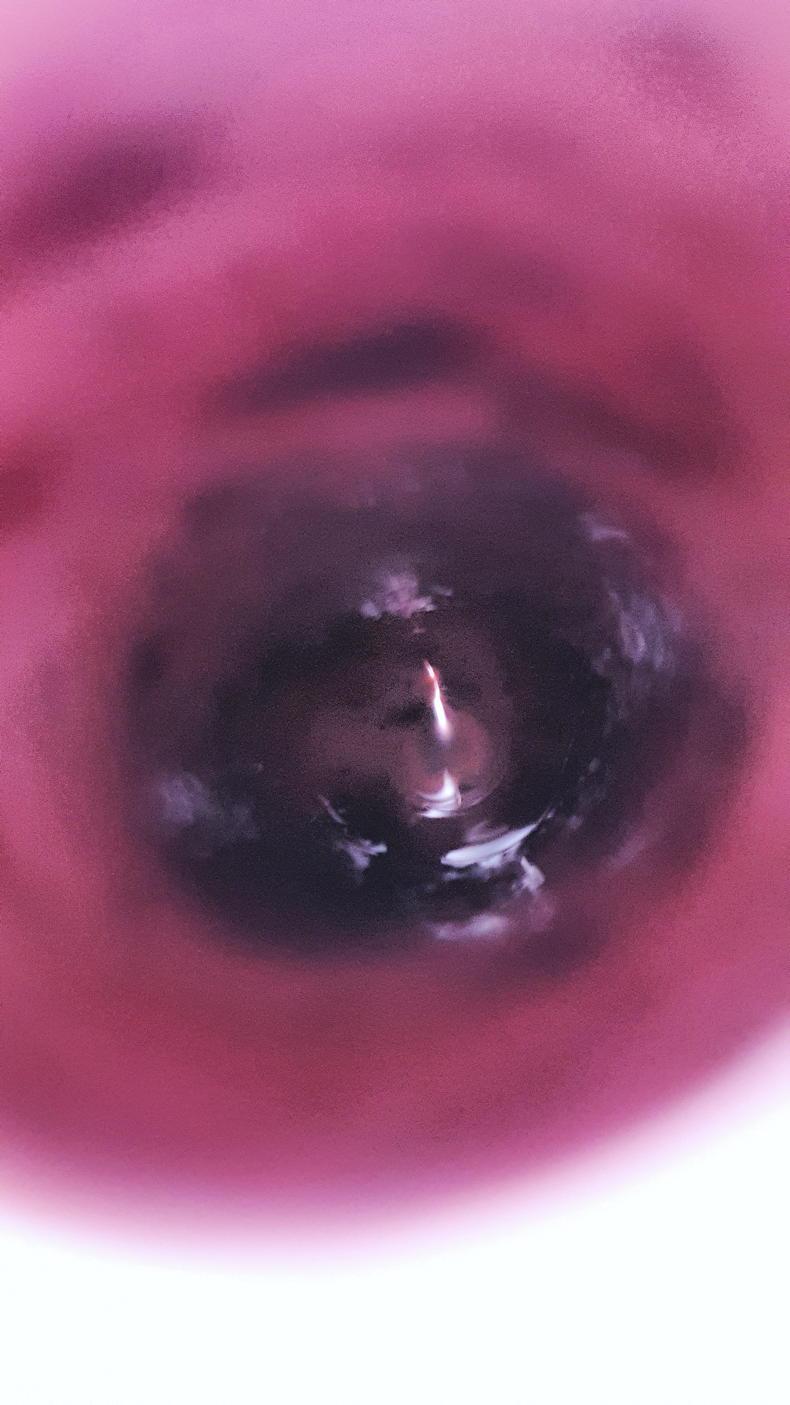
Mould buildup on the inside of a calf teat feeder.
However, on closer inspection, when replacing the few that looked like they needed changing, the farmer was shocked at the state of the inside of teat.
While the outside looked perfectly clean, when the teat was cut open with a knife, a layer of mould was visible on the inside surface of teat.
Feeder hygiene is really important for calf rearing. Any buildup of bacteria or moulds can cause sickness in calves. As outlined above, poor feed hygiene can be a contributing factor to bloat in some cases.
New teats will also help with reducing the speed at which the calf drinks. If calves take too much milk too quickly, it can have negative effects on digestion and calf health. Do not tamper with the hole size in the teat to quicken the feeding process – teats are designed to mimic the flow rate of milk from a cow. At a cost of around €4/teat, it is a small investment to help minimise any risk.
Navel sucking is a problem that develops in some groups of dairy-beef calves.
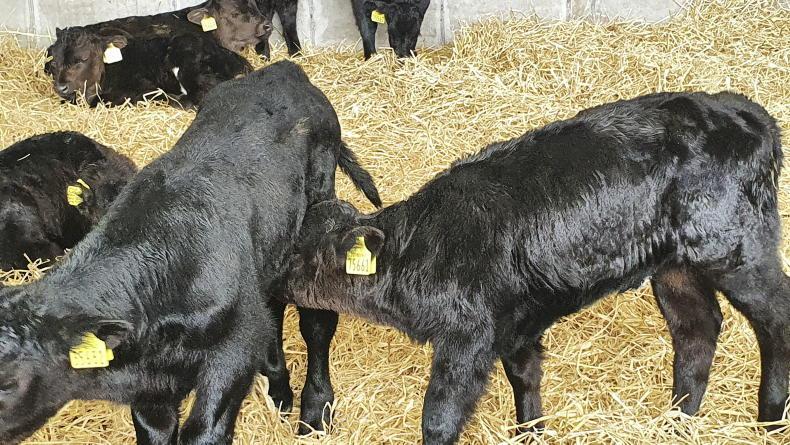
Calf navel sucking.
The problem seems to be particularly bad just after feeding. However, in some cases, it is right throughout the day. This can be a difficult issue to fix as it seems to be a habit that some calves develop and can be hard to stop.
Ensure you are using a highly palatable calf crunch and make sure it is always fresh to encourage intake
The most likely cause of it is that the calf’s appetite is not being fully satisfied by the level of milk feeding. While increasing milk feeds above 3l/feed would not be recommended, the best approach is to try and get calves eating meal as soon as possible.
Make sure that the feed trough is right beside the milk feeder so that calves will move straight towards it once milk feeding has finished.
Ensure you are using a highly palatable calf crunch and make sure it is always fresh to encourage intake.
Another key area to consider is the availability of long fibre to the calf at all times. Straw works perfectly for this but it should be good quality and offered in a hay rack. Make sure the hay rack is not too high as this will inhibit intake. Calves should not have to reach above a natural head height to access it.
Finally, make sure there is fresh water available in all pens for calves to drink at all times. In order to increase meal and forage intake, the calf will need to drink more and more water.
Monitor for navel infections
Keep an eye on calf navels to ensure no bumps or lumps appear on any calf that has been sucked. If in any doubt, consult your vet.
Pneumonia is the single greatest cause of death in young calves. Prevention is always better than a cure. This is where knowing the source of calves can be worth a lot to the beef farmer. Calves need to have received adequate colostrum in the first 24 hours after birth.
While in the ideal world, calves would be vaccinated against pneumonia prior to moving farm, in reality this is not going to happen. Consult your vet about the best approach for your farm with regard to pneumonia vaccination.
Vaccination is a tool in the toolkit to help in pneumonia prevention
Know that a vaccine will not work on a stressed calf and therefore calves should be allowed to settle into the farm for 48 hours prior to vaccination.
Vaccination is a tool in the toolkit to help in pneumonia prevention. A good environment in terms of deep dry-bedding, adequate ventilation and draft management are also essential.
Calf bloat can be an issue in the calf shed any given year. However, speaking to farmers around the country, there seems to be more instances of the problem this year.
Bloat in calves is different to larger animals in that it is the milk stomach or abomasum that rapidly fills with gas, while for older cattle it is the first stomach, or rumen that swells.
Minor cases of bloat occur when the left-hand side of a calf seems swollen
This means that stomach-tubing a calf with bloat is less effective as the tube typically stops in the rumen of a calf that is a few weeks old.
Minor cases of bloat occur when the left-hand side of a calf seems swollen. In bad cases, where both sides of the animal are inflated and extremely hard to the touch, it is recommended that you call your vet who can put a needle directly into the abomasum to relieve the pressure.
Cause
Bloat can occur a few days after arriving on farm, especially for calves transitioning from fresh milk to milk replacer.
Other areas to consider, which can be a source of the problem, revolve around feeding – both hygiene and feed consistency.
Treatment
Treatment for minor instances can be successfully done using baking soda or liquid paraffin.
Isolated instances are not too much of a worry. Where is it a common issue, the first thing you should do is go back to basics. How clean is your feed preparation equipment and feeder (see below). Are you mixing milk replacer exactly to the manufacturer’s recommended rate? Are you weighing out milk replacer accurately? Is your water measurement accurate?
Pulling back the proportion of milk powder for a few days while keeping the water level the same can be a good way to get the problem to settle. Once the issue disappears, you can start to increase the milk powder slowly back to the recommended feed rate.
Having access to clean water at all times is also very important for calves. Milk to calves is a feed and not a drink. Calves have a requirement for water as well. Where water intake is reduced, it can lead to bloat issues or stomach upsets.
Water feeders need to be at the correct height for calves to drink from and should be checked twice daily to ensure water is fresh.
Having feeding equipment perfectly clean for calf-rearing is of utmost importance for calf health.
While visiting a farm that was preparing for calf arrival recently, the topic of teats on the calf feeder came up.

Hygiene around calf feeding equipment is really important in preventing disease outbreaks.
The farmer planned to change any teat that was cracked or leaking but was planning on just changing those that looked like they had seen better days.
The feeders had been thoroughly washed and cleaned with hot water at the end of the rearing phase last year and were stored dry in a shed loft.

Mould buildup on the inside of a calf teat feeder.
However, on closer inspection, when replacing the few that looked like they needed changing, the farmer was shocked at the state of the inside of teat.
While the outside looked perfectly clean, when the teat was cut open with a knife, a layer of mould was visible on the inside surface of teat.
Feeder hygiene is really important for calf rearing. Any buildup of bacteria or moulds can cause sickness in calves. As outlined above, poor feed hygiene can be a contributing factor to bloat in some cases.
New teats will also help with reducing the speed at which the calf drinks. If calves take too much milk too quickly, it can have negative effects on digestion and calf health. Do not tamper with the hole size in the teat to quicken the feeding process – teats are designed to mimic the flow rate of milk from a cow. At a cost of around €4/teat, it is a small investment to help minimise any risk.
Navel sucking is a problem that develops in some groups of dairy-beef calves.

Calf navel sucking.
The problem seems to be particularly bad just after feeding. However, in some cases, it is right throughout the day. This can be a difficult issue to fix as it seems to be a habit that some calves develop and can be hard to stop.
Ensure you are using a highly palatable calf crunch and make sure it is always fresh to encourage intake
The most likely cause of it is that the calf’s appetite is not being fully satisfied by the level of milk feeding. While increasing milk feeds above 3l/feed would not be recommended, the best approach is to try and get calves eating meal as soon as possible.
Make sure that the feed trough is right beside the milk feeder so that calves will move straight towards it once milk feeding has finished.
Ensure you are using a highly palatable calf crunch and make sure it is always fresh to encourage intake.
Another key area to consider is the availability of long fibre to the calf at all times. Straw works perfectly for this but it should be good quality and offered in a hay rack. Make sure the hay rack is not too high as this will inhibit intake. Calves should not have to reach above a natural head height to access it.
Finally, make sure there is fresh water available in all pens for calves to drink at all times. In order to increase meal and forage intake, the calf will need to drink more and more water.
Monitor for navel infections
Keep an eye on calf navels to ensure no bumps or lumps appear on any calf that has been sucked. If in any doubt, consult your vet.




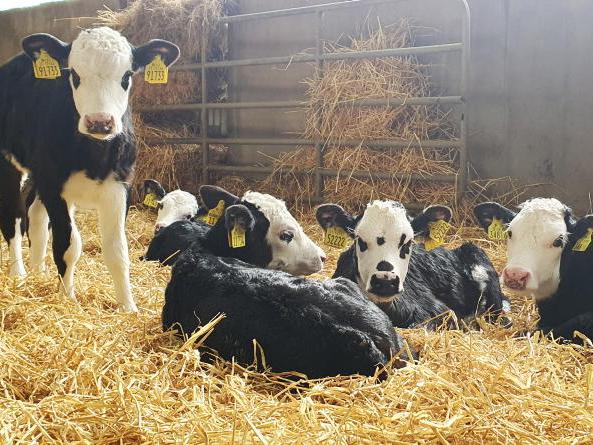




 This is a subscriber-only article
This is a subscriber-only article





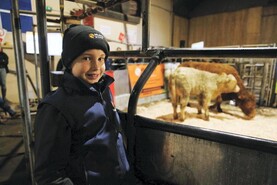




SHARING OPTIONS: